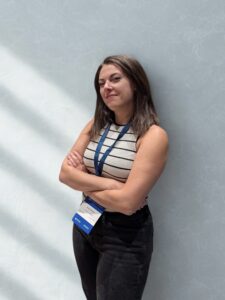
Call: +34 876 555 429
Email: srenda@unizar.es
Address: Office 3.1.11 c/Mariano Esquillor SN Edificio I+D+i, I3A, 50018, Zaragoza (Spain)
Sideral: See the profile (CV)
ABOUT ME
Simona Renda is a Juan de la Cierva postdoctoral researcher, member of the consolidated Catalysis and Reactor Engineering Group (CREG) of the University of Zaragoza since 2023 and of the Aragón Institute for Engineering Research (I3A) since 2025. She holds a BSc and MSc in Chemical Engineering and a PhD in Industrial Engineering – Chemical Engineering Program from the University of Salerno (Italy), awarded with honours.
Her research focuses on catalysis and reactor engineering for environmental applications. She has a consolidated background on the topics of structured catalysts, carbon capture and utilization, and industrial processes such as CO2 hydrogenation, Claus gas treatment, water desalination and propane dehydrogenation. She has experience with both experimental work and CFD modelling, and her projects combine academic research with industrial collaborations. She participated in more than 10 research and technological transfer projects, including two European H2020 projects. As a member of CREG, her current research lines include:
-
- CO2 hydrogenation to e-fuels (dimethyl ether and methanol)
- Innovative fluidized bed reactors with continuous sorbent flux for the process intensification of sorption-enhanced reactions
Her research involves collaborations with over 10 industrial/foreign partners, and she has participated with scientific contributions in over 15 international conferences. She is an active reviewer for several scientific journals and serves on the early career board of Catalysts. She is involved in mentoring and teaching: she has supervised 6 bachelor’s and 9 master’s students, coordinated 5 international internships, and currently directs a PhD thesis on CO₂ utilization. She has participated in didactive activities with courses in the field of catalysis and chemical reaction engineering at the University of Salerno and the University of Zaragoza.
Simona has published more than 30 scientific papers in SCI-indexed journal with more than 800 citations, and has an h-index of 13 (data according to Scopus @December 2025).
Orcid: https://orcid.org/0000-0002-5926-5252
Scopus: https://www.scopus.com/authid/detail.uri?authorId=57212381756
PUBLICATIONS
2026
González-Pizarro, R.; Calero-Berrocal, R.; Lasobras, J.; Renda, S.; Rodríguez-Pardo, M. R.; Soler, J.; Menéndez, M.; Herguido, J.
Tuning e-fuel selectivity in sorption-enhanced CO2 hydrogenation over In2O3/ZrO2: The effect of LTA and FAU zeolites Journal Article
En: Fuel, vol. 406, pp. 136974, 2026, ISSN: 0016-2361.
@article{GONZALEZPIZARRO2026136974,
title = {Tuning e-fuel selectivity in sorption-enhanced CO2 hydrogenation over In2O3/ZrO2: The effect of LTA and FAU zeolites},
author = {R. González-Pizarro and R. Calero-Berrocal and J. Lasobras and S. Renda and M. R. Rodríguez-Pardo and J. Soler and M. Menéndez and J. Herguido},
url = {https://www.sciencedirect.com/science/article/pii/S0016236125026997},
doi = {https://doi.org/10.1016/j.fuel.2025.136974},
issn = {0016-2361},
year = {2026},
date = {2026-01-01},
journal = {Fuel},
volume = {406},
pages = {136974},
abstract = {The e-fuels synthesis via CO2 hydrogenation and the Sorption Enhanced Reaction technology are captivating strategies for CO2 utilization and the integration of renewable energy sources. This study focuses on enhancing the conversion of CO2 over an In2O3/ZrO2 catalyst by incorporating LTA zeolites (3A and 4A) and a FAU zeolite (13X). Key operational parameters, such as temperature (T), Gas Hour Space Velocity (GHSV), type of zeolite, and Zeolite: Catalyst mass ratio (Z/C), were systematically varied. LTA zeolites (3A and 4A) provided the highest CO2 conversions. The introduction of a water-adsorbing solid into the reactor significantly altered the products yield and selectivity. While the selectivity towards CH4, CH3OH, and C2H6O appeared to lay on the type of zeolite, the selectivity towards CO remained unaffected. Zeolite 3A demonstrated the greatest enhancement in selectivity towards CH4 and CH3OH, whereas the synthesis of C2H6O was favored by zeolites 4A and 13X. The Zeolite:Catalyst mass ratio also played a crucial role in process performance, influencing both CO2 conversion and product selectivity. Increasing this ratio improved CO2 conversion and reduced CO selectivity under all operating conditions, while CH4 selectivity increased. However, the selectivity toward CH3OH and C2H6O exhibited an anomalous and complementary behavior. While a maximum was observed for DME, a minimum was registered in methanol production, suggesting a dependency of the dehydration reaction kinetics on the amount of water produced during the reaction.},
keywords = {},
pubstate = {published},
tppubtype = {article}
}
González-Pizarro, R.; Renda, S.; Lasobras, J.; Soler, J.; Menéndez, M.; Herguido, J.
Low loading copper-based catalysts for effective CO2 hydrogenation to methanol Journal Article
En: Fuel, vol. 408, pp. 137642, 2026, ISSN: 0016-2361.
@article{GONZALEZPIZARRO2026137642,
title = {Low loading copper-based catalysts for effective CO2 hydrogenation to methanol},
author = {R. González-Pizarro and S. Renda and J. Lasobras and J. Soler and M. Menéndez and J. Herguido},
url = {https://www.sciencedirect.com/science/article/pii/S001623612503368X},
doi = {https://doi.org/10.1016/j.fuel.2025.137642},
issn = {0016-2361},
year = {2026},
date = {2026-01-01},
journal = {Fuel},
volume = {408},
pages = {137642},
abstract = {Methanol synthesis via CO2 hydrogenation is an emerging Power-to-Liquid (PtL) technology aimed to accelerate the energy transition and the defossilization of key sectors, particularly maritime transport. This study focuses on the study of low loading formulations, to minimize the catalyst cost. Key operational variables including temperature (T), Weight Hourly Space Velocity (WHSV), copper and zinc loadings, and aging state were systematically varied. An overall active phase loading of 10 %wt emerged as optimal. Within this total loading, a 5 %wtCu-5 %wtZn/ZrO2 catalysts delivered higher methanol productivity than 10 %wtCu/ZrO2; however, the bimetallic catalysts showed pronounced deactivation under water-rich atmospheres, establishing 10 %wtCu/ZrO2 as the most promising catalysts. Operating temperature and WHSV exerted a strong, synergistic influence on CH3OH formation; in particular, increasing WHSV shifted the reaction away from thermodynamic control and boosted methanol synthesis. Finally, the catalytic performance of these low-loading catalysts was benchmarked against high-copper-loading methanol catalysts reported in the literature by critically compare their activities as a function of the residence time (τ) calculated at reaction conditions. This assessment revealed that the proposed formulation is highly competitive when compared to most conventional formulation, with a maximum methanol space time yield (STYCH3OH) of 3.9 gCH3OH gCu-1 h-1. This comparison confirms that the catalysts proposed in this study could offer a remarkably more efficient use of the active phase than the conventional high-copper-loading catalysts.},
keywords = {},
pubstate = {published},
tppubtype = {article}
}
Renda, Simona; Soler, Jaime; Menéndez, Miguel; Herguido, Javier
Doped In2O3/ZrO2 catalysts to drive selectivity toward DME in one-pot CO2 hydrogenation Journal Article
En: Applied Catalysis A: General, vol. 710, pp. 120682, 2026, ISSN: 0926-860X.
@article{RENDA2026120682,
title = {Doped In2O3/ZrO2 catalysts to drive selectivity toward DME in one-pot CO2 hydrogenation},
author = {Simona Renda and Jaime Soler and Miguel Menéndez and Javier Herguido},
url = {https://www.sciencedirect.com/science/article/pii/S0926860X25005848},
doi = {https://doi.org/10.1016/j.apcata.2025.120682},
issn = {0926-860X},
year = {2026},
date = {2026-01-01},
journal = {Applied Catalysis A: General},
volume = {710},
pages = {120682},
abstract = {This study investigates single-pass dimethyl ether synthesis at mild pressure conditions using novel bifunctional catalysts based on indium-modified formulations and incorporating Ni, Cu, Pt, and Pd as active metals. Additionally, the substitution of the conventional HZSM-5 zeolite with 4A zeolite as the dehydration component was evaluated. Although 4A zeolite exhibited lower dehydration activity, it contributed to an overall improvement in DME selectivity. The incorporation of secondary metals into the In2O3-ZrO2 formulation reduced catalytic activity but enhanced selectivity, ultimately increasing DME yield. The formation of by-products such as light olefins and methane was significantly dependent on the metal used: Ni, Pt, and Pd reduced olefin production, though Ni promoted excessive methane formation across the whole temperature range. Notably, the Pt-based catalyst completely suppressed by-product formation across the temperature range studied. While the In2O3-ZrO2-based catalysts generally displayed lower space–time yields than the commercial reference, they achieved comparable performance at 280 °C. Due to their superior selectivity, these formulations are promising for developing even better performing catalysts, to be excellent candidates in industrial processes, where the operation with recycle loops requires a high product purity.},
keywords = {},
pubstate = {published},
tppubtype = {article}
}
2025
González Pizarro, Rodrigo; Lasobras Laguna, Javier; Renda, Simona; Soler Herrero, Jaime; Menéndez, Miguel; Herguido, Javier
vol. 13, 2025.
@proceedings{GonzálezPizarro_LasobrasLaguna_Renda_SolerHerrero_Menéndez_Herguido_2025,
title = {Intensificación del proceso para la producción de gas de síntesis via (LT-rWGS): un reactor de lecho fluidizado con alimentación continua de sorbente (CSF)},
author = {González Pizarro, Rodrigo and Lasobras Laguna, Javier and Renda, Simona and Soler Herrero, Jaime and Menéndez, Miguel and Herguido, Javier},
url = {https://papiro.unizar.es/ojs/index.php/jji3a/article/view/11917},
doi = {10.26754/jji-i3a.202511917},
year = {2025},
date = {2025-07-01},
urldate = {2025-07-01},
journal = {Jornada de Jóvenes Investigadores del I3A},
volume = {13},
keywords = {},
pubstate = {published},
tppubtype = {proceedings}
}
Saraceno, Emilia; Renda, Simona; Menéndez, Miguel; Palma, Vincenzo
Study on the Fluidization of Mixture of Plastic Waste and Alumina Proceedings
vol. 13, 2025.
@proceedings{Saraceno_Renda_Menéndez_Palma_2025,
title = {Study on the Fluidization of Mixture of Plastic Waste and Alumina},
author = {Saraceno, Emilia and Renda, Simona and Menéndez, Miguel and Palma, Vincenzo},
url = {https://papiro.unizar.es/ojs/index.php/jji3a/article/view/12010},
doi = {10.26754/jji-i3a.202512010},
year = {2025},
date = {2025-07-01},
urldate = {2025-07-01},
journal = {Jornada de Jóvenes Investigadores del I3A},
volume = {13},
keywords = {},
pubstate = {published},
tppubtype = {proceedings}
}

